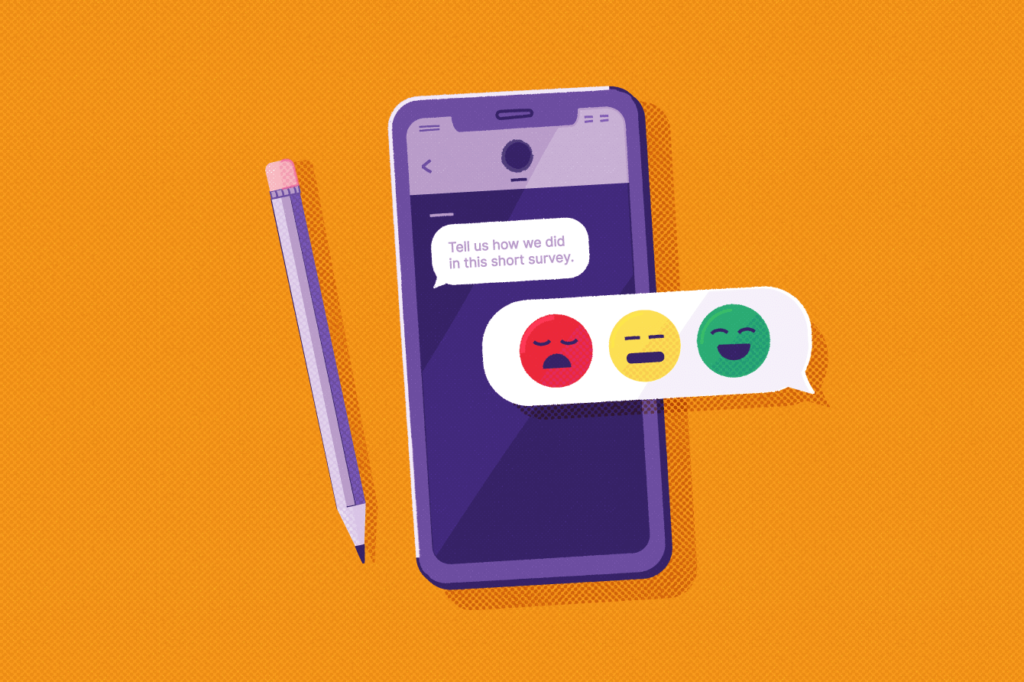Obtaining customer feedback and opinions is an essential part of running your service organization. As the most relevant data to inform whether you have unhappy customers or need to improve customer experience, customer feedback should steer the ship of any customer support team.
While it’s important to gauge the level of customer satisfaction, it’s also necessary to obtain their feedback on your product or service and identify their wants and needs. Only through this level of understanding, can you begin to create personal relationships with your customers and make the continuous improvements necessary to build long-term customer loyalty.
Interestingly, most businesses don’t regularly conduct CSAT surveys to better understand their customers. Much more focus is placed on sales and profit with far less concern over whether the customer is satisfied. Yet, at the end of the day, it’s all about customer satisfaction. Without happy customers, there are no sales and no profits.
Fortunately, there have never been more ways to integrate a satisfaction survey into your customers’ interactions. Surveys can be conducted on nearly every communication channel that you offer—from email and IVR to text, outbound voice, social media, or chat. For the best results, ask questions on the channels that your customers are most apt to use.
Why gather customer feedback?
Short answer: You need customer feedback to improve.
Can you rely on data like first-time resolution and call volume to gauge the type of experience your customers are having? You definitely should. But operational data only tells one side of the story.
Customer feedback is the only way to find out if you have unhappy customers. Even hold time isn’t necessarily an indicator of that, since many customers are willing to wait virtually via a callback for much longer without impacting their NPS or customer experience.
Mature brands can dig even deeper into customer feedback with open ended questions, pulling out key ways to improve their product or service directly from the people that consume it.
Bottom line: You’re missing out on an entire side of the customer experience when you skip on customer feedback.
Reap the benefits of gathering customer feedback.
Obviously gathering customer feedback takes more work than doing nothing. While there’s a cost associated with gathering feedback—infrastructure, software, time evaluating, effort to enact changes—the pros far outweigh the cons.
Improve the customer experience.
Feedback signals the highs and lows of your customer experience. It’s the clearest indicator of what to either fix or amplify. And since there are clear lines drawn between experience and revenue, acting on survey feedback could mean the difference when retaining a customer.
Improve customer service.
The most common place to request customer satisfaction feedback is via a customer service survey. When you combine operational data (number of chat messages, time to resolution, etc.) with customer satisfaction feedback (like a CSAT score) and open-ended input, you can improve nearly every aspect of your customer service org.
Quick tip: Immediate customer feedback is the most impactful. Follow up a voice interaction with a texted link to a survey for higher take rates and quick completion.
Evolve your product line.
Sales revenue tells the story of how well your product is resonating with the market today. But that’s not the full story of how consumer demand might be shifting.
Customer feedback is ripe with trends that can improve your products in the future, with enhancements suggested directly by those who are most likely to buy again in the future.
Build stronger brand advocates.
For a customer, part of brand loyalty is having the sense that you’re understood, met, and valued by the brand you choose to trust. A satisfaction survey collects info for the brand—but it also gives customers the opportunity to be heard.
Quick tip: Closing the loop is key to building brand advocacy. Immediately following up on feedback with a text shows customers that their voice is important to your brand. Follow up positive feedback with a note of gratitude (include a coupon or discount), and get in touch with unhappy customers by letting them schedule a time to talk that works best for their schedule.
The best ways to collect customer feedback
The way you collect feedback is almost as important as the feedback itself. If it’s difficult for a customer to fill out a survey, they’re not likely to complete it.
There are also entire research institutions and consulting firms dedicated to survey science, so honing in on the best practices for collecting feedback is crucial.
Use both long- and short-form customer surveys.
For well-rounded and insightful findings, utilize both long-form and short-form surveys. Many brands start with a Likert scale ranking around the experience as a whole, and then dig into more specifics as the survey goes on (for customers that are willing to fill out more of the survey).
Collect feedback asynchronously.
Since even rudimentary feedback is so critical, collecting even basic feedback with text messaging can lead to higher take rates and more data for you to dig into.
Instead of relying on customers to stay on the phone for 3 extra minutes, give them the chance to text you a score instead of using a dial pad. You’re more likely to get immediate feedback (which is the most informative), and customers may even return to the survey later in the day, which is an opportunity not afforded via voice.
Use Net Promoter Score surveys.
The Net Promoter Score (NPS) is a metric based on one simple question: How likely are you to recommend the brand to a friend or colleague? Respondents can answer from 0 (not likely at all) to 10 (extremely likely). Based on their answers, customers are categorized as promoters, passives or detractors.
Many believe that NPS is closely aligned with levels of customer loyalty. The higher the NPS, the greater the loyalty. To maximize the true value of NPS, it’s important to use the number as a jumping off point for developing programs and strategies to improve it.
How to use your customer feedback
Focus on more than the numbers.
Of course, customer feedback is only useful if it’s insightful and can be used to make business decisions. This begins with asking the right survey questions. The most beneficial surveys include open-ended questions that enable customers to provide specific, actionable feedback.
It’s easy to review ratings and evaluate scores. However, these numbers don’t provide any insight into customers’ rationale for their answers. By asking for your customers’ opinions, you can glean valuable details that help you understand your customers’ decisions and behaviors.
Delve into customer feedback.
It’s a common mistake to review surveys and then file them without analysis. Results should be shared and reviewed by the entire service team. Take ample time to closely evaluate responses and consider opportunities for improvement. Keep a close watch out for trends that indicate common frustrations customers have, as well as areas where customers were delighted.
Surveys shouldn’t be considered a mundane administrative task. Instead, customer feedback should be thought of as one of the most important tools used to sustain long-term success.
Identify product improvement areas.
Having a direct loop into product development can identify ways to improve your product. Make sure customer feedback is incorporated into the product roadmap by delivering insights and results across the organization.
Refine your niche.
Positive customer feedback lets you identify who your people are! Use this data to identify your promoters, refine your target audience, and get really good at reaching them.
Prevent a bad reputation.
Closing the loop can be vital to resolving a customer complaint before it goes viral or reaches your broader audience. Automating a chance to schedule a callback for upset customers not only shows them you care, but puts them in control of the experience by scheduling a follow-up call at their convenience. It’s a small but noteworthy difference in how you treat a customer.
Foster brand advocacy.
Customers that give the most glowing reviews are more likely to advocate for your brand with their network. Consider following up with these brand enthusiasts with an ask to share their experience on social media, or invite them to your loyalty program if you have one.
Develop a culture that promotes honest results.
Do you tie bonuses or incentives to the results of customer satisfaction surveys? It’s likely that agents are feeling pressured to offer extras to customers, or to prod customers to give top marks on surveys. This skews results and doesn’t provide you with the insights you need to make smart decisions.
The goal isn’t to achieve perfect results. Aim to have the customer provide honest feedback about their experience.
Empower employees.
Low feedback scores are often a result of agents not being able to provide the service level that customers expect. This can be a result of a bad company policy, issues with contact center infrastructure, illogical routing decisions, or insufficient staffing or training.
To meet customer expectations, agents need to be able to effectively do their jobs. Agents should also not fear reprisal for low survey scores that are reflective of issues that are beyond their control.
Looking for an edge with your workforce? Learn how to use customer satisfaction scores to empower CX employees.
Don’t live in denial.
Are your survey answers consistently not up to par? Many will be tempted to sweep them under the rug and continue on with business as usual. However, negative surveys are worth their weight in gold, as they can highlight the improvements necessary to continue growing your business and customer loyalty. Embrace feedback, both positive and negative, and use it constructively.
Reach out to customers post-survey.
Surveys also provide an opportunity to rectify a bad interaction or resolve a complaint. Consider proactively reaching out to customers who do take the time to complete surveys. This follow-up should happen as soon as possible to communicate your eagerness to right a wrong.
Quick tip: Automate it! Texts are ubiquitous for the majority of customers—use them to immediately reach out after an interaction and request a survey or offer a chance to schedule a call with a customer experience specialist.
Summing up
It’s a simple fact that the organizations that thrive are those that can achieve a consistent rate of happy customers. To keep customers happy on an ongoing basis, you need to understand them. This requires regular surveying to stay on top of customer feelings and opinions by benchmarking their level of satisfaction and loyalty.
This post was originally published in February 2017 and has since been updated.





